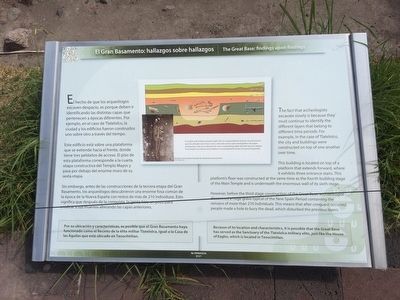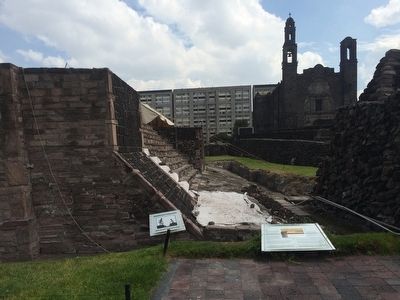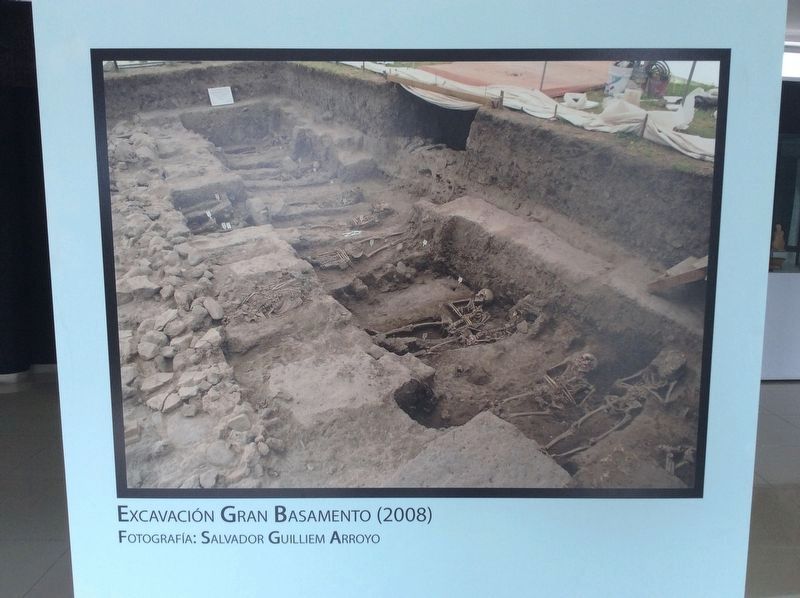Colonia Tlatelolco in Ciudad de México, Mexico — The Valley of Mexico (The Central Highlands)
The Great Base: findings upon findings
El Gran Basamento: hallazgos sobre hallazgos
El hecho de que los arqueólogos excaven despacio, es porque deben ir identificando las distintas capas que pertenecen a épocas diferentes. Por ejemplo, en el caso de Tlatelolco, la ciudad y los edificios fueron construidos uno sobre otro a través del tiempo.
Este edificio está sobre una plataforma que se extiende hacia el frente, donde tiene tres peldaños de acceso. El piso de esta plataforma corresponde a la cuarta etapa constructiva del Templo Mayor y pasa por debajo del enorme muro de su sexta etapa.
Sin embargo, antes de las construcciones de la tercera etapa del Gran Basamento, los arqueólogos descubrieron una enorme fosa común de la época de Nueva España con restos de más de 210 individuos. Esto significa que después de la conquista, la gente hizo un pozo para enterrar a sus muertos alterando las capas anteriores.
Por su ubicación y características, es possible que el Gran Basamento haya funcionado como el Recinto de la élite militar Tlatelolca, igual a la Casa de la Águilas que está ubicado en Tenochtitlan.
Pie de dibujos:
En la época de la Nueva España (Siglo XVI), los conquistadores hicieron una excavación que fue utilizada como fosa común, alterando así las capas estratigráficas de origen prehispánico. Éste es un ejemplo de cómo el arqueólogo debe descifrar que dos objetos encontrados a la misma profundidad, no necesariamente tienen la misma antigüedad.
Entierro encontrado durante las recientes excavaciones. Foto: Miguel Marín
The fact that archeologists excavate slowly is because they must continue to identify the different layers that belong to different time periods. For example, in the case of Tlatelolco, the city and buildings were constructed on top of one another over time.
This building is located on top of a platform that extends forward, where it exhibits three entrance stairs. This platform’s floor was constructed at the same time as the fourth building stage of the Main Temple and is underneath the enormous wall of its sixth stage.
However, before the third stage construction of the Great Base, archaeologist discovered a huge grave typical of the New Spain Period containing the remains of more than 210 individuals. This means that after conquest occurred, people made a hole to bury the dead, which disturbed the previous layers.
Because of its location and characteristics, it is possible that the Great Base has served as the Sanctuary of the Tlatelolca military elite, just like the House of Eagles, which is located in Tenochtitlan.
English translation of the captions:
During the period of New Spain (16th century) the conquistadors made an excavation that was used as a common grave, altering the normal soil layers of prehispanic origin. This is an example of the analysis that an archaeologist must do when two objects found at the same depth don’t necessarily have the same age.
A burial found during recent excavations. Photo: Miguel Marín
Topics. This historical marker is listed in these topic lists: Anthropology & Archaeology • Man-Made Features.
Location. 19° 27.095′ N, 99° 8.271′ W. Marker is in Ciudad de México. It is in Colonia Tlatelolco. The marker is at the Tlatelolco Archeological Site on Eje Central near the intersection with Avenida Ricardo Flores Magón. Touch for map. Marker is in this post office area: Ciudad de México 06900, Mexico. Touch for directions.
Other nearby markers. At least 8 other markers are within walking distance of this marker. Templo Mayor: a temple built eight times (within shouting distance of this marker); Between the past and the modern times (within shouting distance of this marker); El Temazcal (within shouting distance of this marker); Tlatelolco (within shouting distance of this marker); Stage 1 of the Templo Mayor de Mexico Tlatelolco (within shouting distance
of this marker); Favor request…and talent for the gods (within shouting distance of this marker); Coyolxauhqui: The dismembered goddess (within shouting distance of this marker); Walls and roads: limits and communication (within shouting distance of this marker). Touch for a list and map of all markers in Ciudad de México.

Photographed By J. Makali Bruton, November 2, 2015
4. Did you know…?
A few steps north of The Great Base marker is this educational marker which reads: ¿Sabías que…
• Frente al Templo Mayor está la Gran Plataforma Poniente, es de forma rectangular y tiene dos altares: el del sur es circular y quizá dedicado a Quetzalcóatl. El del norte es rectangular y probablemente dedicado a Xipe Tótec.
• Justo frente a la esquina noroeste del Templo Mayor, hay dos enormes edificios: el Gran Basamento, elaborado de cantera rosa y al oriente otro edificio muy similar, aunque más pequeño y de construcción más pobre.
• Se observan (a mayor altura del resto del conjunto) restos de muros, núcleos y pisos, los cuales fueron construidos en épocas posteriores al Gran Basamento.
• También hay dos altares circulares orientados hacia el sur, mismos que quizá se usaban para que la gente colocara ofrendas a los dioses.
• Justo en la esquina noroeste de la Zona Arqueológica se encuentra un “templo enano”. ¡Mide tan sólo 1 metro cuadro y 70 centímetros de altura!
English:
• In front of the Main Temple is the Great Western Platform. It has a rectangular shape and two altars: the southern one is circular and might have been dedicated to Quetzalcoatl. The northern altar is rectangular and was probably dedicated to Xipe Totec.
• Right in front of the northwest corner of the Main Temple, there are two enormous buildings: the Great Base, made from pink quarry, and to the East there is another similar building, although it is smaller and of lower quality.
• From a higher altitude, one can observe the rest of the walls, nuclei, and floors, which were constructed sometime after the Great Base.
• There are also two circular altars facing southward, which may have been used so that people could leave offerings for the gods.
• Right on the northwest corner of the Archeological Zone, we find a “dwarf temple.” It only measures 10ft2 and 28 inches high!
• Frente al Templo Mayor está la Gran Plataforma Poniente, es de forma rectangular y tiene dos altares: el del sur es circular y quizá dedicado a Quetzalcóatl. El del norte es rectangular y probablemente dedicado a Xipe Tótec.
• Justo frente a la esquina noroeste del Templo Mayor, hay dos enormes edificios: el Gran Basamento, elaborado de cantera rosa y al oriente otro edificio muy similar, aunque más pequeño y de construcción más pobre.
• Se observan (a mayor altura del resto del conjunto) restos de muros, núcleos y pisos, los cuales fueron construidos en épocas posteriores al Gran Basamento.
• También hay dos altares circulares orientados hacia el sur, mismos que quizá se usaban para que la gente colocara ofrendas a los dioses.
• Justo en la esquina noroeste de la Zona Arqueológica se encuentra un “templo enano”. ¡Mide tan sólo 1 metro cuadro y 70 centímetros de altura!
English:
• In front of the Main Temple is the Great Western Platform. It has a rectangular shape and two altars: the southern one is circular and might have been dedicated to Quetzalcoatl. The northern altar is rectangular and was probably dedicated to Xipe Totec.
• Right in front of the northwest corner of the Main Temple, there are two enormous buildings: the Great Base, made from pink quarry, and to the East there is another similar building, although it is smaller and of lower quality.
• From a higher altitude, one can observe the rest of the walls, nuclei, and floors, which were constructed sometime after the Great Base.
• There are also two circular altars facing southward, which may have been used so that people could leave offerings for the gods.
• Right on the northwest corner of the Archeological Zone, we find a “dwarf temple.” It only measures 10ft2 and 28 inches high!
Credits. This page was last revised on April 17, 2020. It was originally submitted on January 4, 2016, by J. Makali Bruton of Accra, Ghana. This page has been viewed 312 times since then and 8 times this year. Photos: 1, 2. submitted on January 4, 2016, by J. Makali Bruton of Accra, Ghana. 3. submitted on August 12, 2017, by J. Makali Bruton of Accra, Ghana. 4. submitted on January 4, 2016, by J. Makali Bruton of Accra, Ghana.


